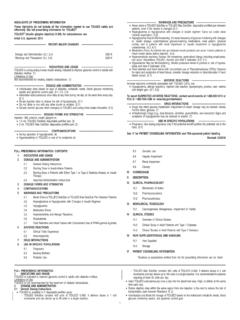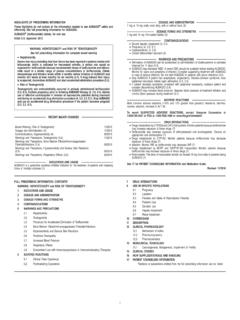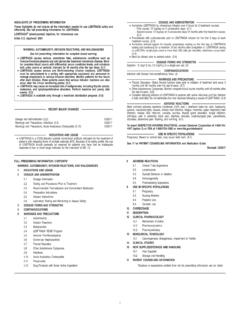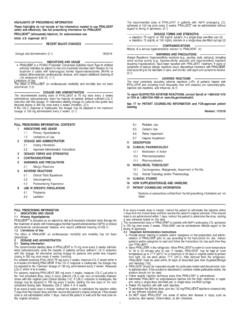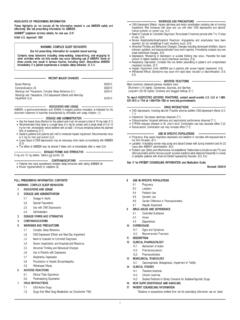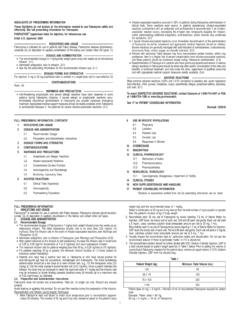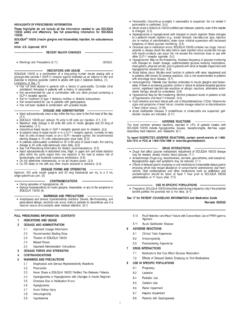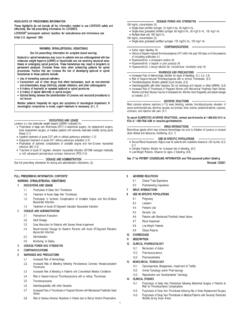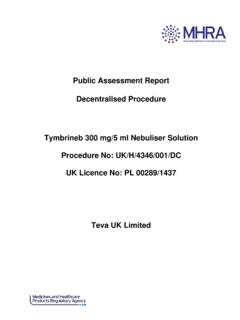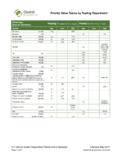Transcription of RIFADIN Rx Only Plasma concentrations after the 600 mg ...
1 RIFADIN Rx only Plasma concentrations after the 600 mg dose, which were disproportionately higher (up ( rifampin capsules USP) to 30% greater than expected) than those found after the 300 mg dose, indicated that the and elimination of larger doses was not as rapid. RIFADIN IV after repeated once-a-day infusions (3-hr duration) of 600 mg in patients (n=5) for 7 days, ( rifampin for injection USP) concentrations of IV rifampin decreased from mcg/mL 8 hours after the infusion To reduce the development of drug-resistant bacteria and maintain the effectiveness of on day 1 to mcg/mL 8 hours after the infusion on day 7. rifampin is widely distributed throughout the body. It is present in effective concentrations RIFADIN ( rifampin capsules USP) and RIFADIN IV ( rifampin for injection USP) and other in many organs and body fluids, including cerebrospinal fluid.
2 rifampin is about 80%. antibacterial drugs, rifampin should be used only to treat or prevent infections that are protein bound. Most of the unbound fraction is not ionized and therefore diffuses freely into proven or strongly suspected to be caused by bacteria. tissues. DESCRIPTION rifampin is rapidly eliminated in the bile and undergoes progressive enterohepatic RIFADIN ( rifampin capsules USP) for oral administration contain 150 mg or 300 mg circulation and deacetylation to the primary metabolite, 25-desacetyl- rifampin . This rifampin per capsule . The 150 mg and 300 mg capsules also contain, as inactive metabolite is microbiologically active. Less than 30% of the dose is excreted in the urine ingredients: corn starch, D&C Red No.
3 28, FD&C Blue No. 1, FD&C Red No. 40, gelatin, as rifampin or metabolites. Serum concentrations do not differ in patients with renal failure magnesium stearate, and titanium dioxide. at a studied dose of 300 mg, and consequently, no dosage adjustment is required. RIFADIN IV ( rifampin for injection USP) contains rifampin 600 mg, sodium formaldehyde Pediatrics sulfoxylate 10 mg, and sodium hydroxide to adjust pH. Oral Administration rifampin is a semisynthetic antibiotic derivative of rifamycin SV. rifampin is a red-brown In one study, pediatric patients 6 to 58 months old were given rifampin suspended in crystalline powder very slightly soluble in water at neutral pH, freely soluble in chloroform, simple syrup or as dry powder mixed with applesauce at a dose of 10 mg/kg body weight.
4 Soluble in ethyl acetate and in methanol. Its molecular weight is and its chemical Peak serum concentrations of and mcg/mL were obtained 1 hour after formula is C43H58N4O12. The chemical name for rifampin is either: preprandial ingestion of the drug suspension and the applesauce mixture, respectively. 3-[[(4-Methyl-1-piperazinyl)imino]methyl ]rifamycin after the administration of either preparation, the t of rifampin averaged hours. It or should be noted that in other studies in pediatric populations, at doses of 10 mg/kg body 5,6,9,17,19,21-hexahydroxy-23-methoxy-2, 4,12,16,18,20,22 weight, mean peak serum concentrations of mcg/mL to 15 mcg/mL have been heptamethyl-8-[N-(4-methyl-1-piperazinyl )formimidoyl]-2,7-(epoxypentadeca[1,11,1 3] reported.)
5 Trienimino)naphtho[2,1-b]furan-1,11(2H)- dione 21-acetate. Intravenous Administration In pediatric patients to years old (n=12), the mean peak serum concentration Its structural formula is: of rifampin at the end of a 30-minute infusion of approximately 300 mg/m2 was mcg/mL; individual peak concentrations 1 to 4 days after initiation of therapy ranged from to mcg/mL; individual peak concentrations 5 to 14 days after initiation of therapy were to mcg/mL. The individual serum half-life of rifampin changed from to hours early in therapy to to hours 5 to 14 days after therapy was initiated. Microbiology Mechanism of Action rifampin inhibits DNA-dependent RNA polymerase activity in susceptible Mycobacterium tuberculosis organisms.
6 Specifically, it interacts with bacterial RNA polymerase but does not inhibit the mammalian enzyme. Resistance Organisms resistant to rifampin are likely to be resistant to other rifamycins. In the treatment of both tuberculosis and the meningococcal carrier state (see INDICATIONS AND USAGE), the small number of resistant cells present within large populations of susceptible cells can rapidly become predominant. In addition, resistance to rifampin has been determined to occur as single-step mutations of the CLINICAL PHARMACOLOGY DNA-dependent RNA polymerase. Since resistance can emerge rapidly, appropriate Oral Administration susceptibility tests should be performed in the event of persistent positive cultures. rifampin is readily absorbed from the gastrointestinal tract.
7 Peak serum concentrations in Activity in vitro and in vivo healthy adults and pediatric populations vary widely from individual to individual. Following rifampin has bactericidal activity in vitro against slow and intermittently growing M. a single 600 mg oral dose of rifampin in healthy adults, the peak serum concentration tuberculosis organisms. averages 7 mcg/mL but may vary from 4 to 32 mcg/mL. Absorption of rifampin is reduced rifampin has been shown to be active against most strains of the following microorgan- by about 30% when the drug is ingested with food. isms, both in vitro and in clinical infections as described in the INDICATIONS AND USAGE. rifampin is widely distributed throughout the body. It is present in effective concentrations section.
8 In many organs and body fluids, including cerebrospinal fluid. rifampin is about 80% Aerobic Gram-Negative Microorganisms: protein bound. Most of the unbound fraction is not ionized and, therefore, diffuses freely Neisseria meningitidis into tissues. Other Microorganisms: In healthy adults, the mean biological half-life of rifampin in serum averages Mycobacterium tuberculosis hours after a 600 mg oral dose, with increases up to hours reported after a 900 The following in vitro data are available, but their clinical significance is unknown. mg dose. With repeated administration, the half-life decreases and reaches average rifampin exhibits in vitro activity against most strains of the following microorganisms;. values of approximately 2 to 3 hours.
9 The half-life does not differ in patients with renal however, the safety and effectiveness of rifampin in treating clinical infections due to these failure at doses not exceeding 600 mg daily, and, consequently, no dosage adjustment is microorganisms have not been established in adequate and well-controlled trials. required. The half-life of rifampin at a dose of 720 mg daily has not been established in Aerobic Gram-Positive Microorganisms: patients with renal failure. Following a single 900 mg oral dose of rifampin in patients with Staphylococcus aureus (including Methicillin-Resistant S aureus/MRSA). varying degrees of renal insufficiency, the mean half-life increased from hours in Staphylococcus epidermidis healthy adults to , , and hours in patients with glomerular filtration rates of 30 Aerobic Gram-Negative Microorganisms: to 50 mL/min, less than 30 mL/min, and in anuric patients, respectively.
10 Refer to the Haemophilus influenzae WARNINGS section for information regarding patients with hepatic insufficiency. Other Microorganisms: after absorption, rifampin is rapidly eliminated in the bile, and an enterohepatic circulation Mycobacterium leprae ensues. During this process, rifampin undergoes progressive deacetylation so that nearly -lactamase production should have no effect on rifampin activity. all the drug in the bile is in this form in about 6 hours. This metabolite has antibacterial Susceptibility Testing activity. Intestinal reabsorption is reduced by deacetylation, and elimination is facilitated. For specific information regarding susceptibility test criteria and associated test methods Up to 30% of a dose is excreted in the urine, with about half of this being unchanged drug.

